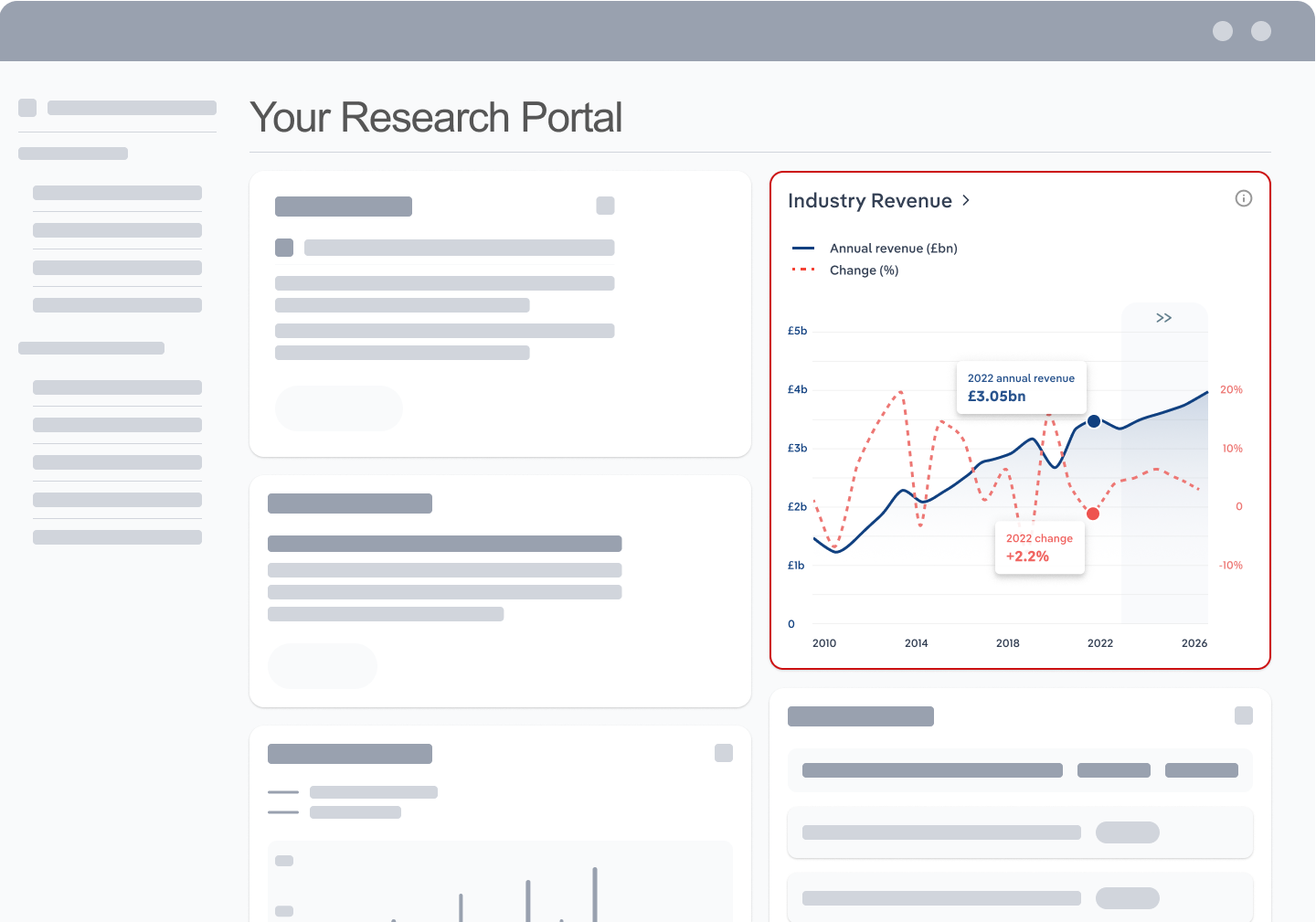Industry Statistics and Trends
Market size and recent performance (2015-2030)
Industry revenue has grown at a CAGR of 10.9 % over the past five years, to reach an estimated $142.2bn in 2025.
Trends and Insights
The building of new information infrastructure boosts industry growth
- In recent years, China has been at the forefront of promoting the construction and coverage of new information infrastructure. The development of advanced technologies like 5G and gigabit optical networks has been a key focus. These efforts are complemented by the strategic planning and implementation of national initiatives in areas like the Internet of Things (IoT) and big data.
- Additional trends and insights available with purchase
Industry outlook (2025-2030)
Market size is projected to grow over the next five years.
Trends and Insights
Automated production will improve industry productivity
- An increasing number of manufacturing processes will incorporate intelligent and automated technologies, like IoT, machine learning, and AI. These technologies are expected to significantly enhance production efficiency and product quality. Additionally, automated production will help minimize errors resulting from human factors and reduce labor costs.
Biggest companies in the Smart Phone Manufacturing in China
| Company | Market Share (%)
2025 | Revenue ($m)
2025 |
|---|---|---|
Vivo Communication Technology Co. Ltd. | 48,897.4 | |
Apple Inc. | 26,451.0 | |
Huawei Technologies Co., Ltd. | 22,775.2 |
To view the market share and analysis for all 13 top companies in this industry, view purchase options.
Products & Services Segmentation
Industry revenue is measured across several distinct product and services lines, including Mobile communication terminal, Communication network equipment and Other receiving equipment. Mobile communication terminal is the largest segment of the Smart Phone Manufacturing in China.
Trends and Insights
Mobile communication terminals represent one of the most significant segments of the industry
- These terminals include devices designed for calling, texting, and other communication purposes. Examples include mobile phones and car phones, which are directly used by consumers.
- More insights available in the full report
Table of Contents
About this industry
Industry definition
Firms in the Smartphone Manufacturing industry in China manufacture mobile phones with advanced PC-like capabilities. Smartphones have independent operating systems and can install software applications developed by third parties. Smartphones also connect to wireless internet networks, usually through mobile communication networks. Operating systems for smartphones include Symbian, Meego, Android, Windows Phone and iOS.
What's included in this industry?
Products and services covered in the Smart Phone Manufacturing industry in China include Mobile communication terminal, Communication network equipment and Other receiving equipment.Companies
Companies covered in the Smart Phone Manufacturing industry in China include Vivo Communication Technology Co. Ltd., Apple Inc. and Huawei Technologies Co., Ltd.Purchase this report to view all 13 major companies in this industry.
Related Terms
Related terms covered in the Smart Phone Manufacturing industry in China include global system for mobile communications (gsm), code-division multiple access (cdma), time-division synchronous cdma (td-scdma), enhanced data rate for gsm evolution (edge) and 3c.Performance
Get an indication of the industry's health through historical, current and forward-looking trends in the performance indicators that make or break businesses.
Analyst insights
Demand for smartphones has grown strongly over the past five years. Due to the rapid development of 4G and 5G technology, an abundant smartphone product portfolio and competi...
In this chapter (4)
- Current Performance
- Outlook
- Volatility
- Life Cycle
Key metrics
- Annual Revenue, Recent Growth, Forecast, Revenue Volatility
- Number of Employees, Recent Growth, Forecast, Employees per Business, Revenue per Employee
- Number of Businesses, Recent Growth, Forecast, Employees per Business, Revenue per Business
- Total Profit, Profit Margin, Profit per Business
Charts
- Revenue, including historical (2015-2024) and forecast (2025-2030)
- Employees, including historical (2015-2024) and forecast (2025-2030)
- Businesses, including historical (2015-2024) and forecast (2025-2030)
- Profit, including historical (2015-2025)
- Industry Volatility vs. Revenue Growth
- Industry Life Cycle
Detailed analysis
- Trends in supply, demand and current events that are driving current industry performance
- Expected trends, economic factors and ongoing events that drive the industry's outlook
- Key success factors for businesses to overcome volatility
- How contribution to GDP, industry saturation, innovation, consolidation, and technology and systems influence the industry's life cycle phase.
Products and Markets
Learn about an industry's products and services, markets and trends in international trade.
Analyst insight
Most of the products in the industry are mobile communication terminals. This part of the product has many application scenarios and huge market segments.
In this chapter
- Products & Services
- Major Markets
- International Trade
Key metrics
- Largest market segment and value in 2025
- Product innovation level
- Total imports, level and trend
- Total exports, level and trend
- Trade Balance
Charts
- Products & services segmentation in 2025
- Major market segmentation in 2025
- International trade, including imports by country and exports by country
Detailed analysis
- Trends impacting the recent performance of the industry's various segments
- Innovations in the industry's product or service offering, specialization or delivery method
- Key factors that successful businesses consider in their offerings
- Buying segments and key trends influencing demand for industry products and services
- Recent trends in import and export volumes, country of origin or destination, and expected future trends
Geographic Breakdown
Discover where business activity is most concentrated in an industry and the factors driving these trends to find opportunities and conduct regional benchmarking.
Analyst insights
Guangdong province is a major producer of industrial products. Guangdong province has a well-developed industrial chain that can meet a large number of downstream demands.
In this chapter (1)
- Business Locations
Charts
- Share of revenue, establishment, wages and employment in each region
- Share of population compared to establishments in each region in 2025
Tables
- Number and share of establishments in each region in 2025
- Number and share of revenue each region accounts for in 2025
- Number and share of wages each region accounts for in 2025
- Number and share of employees in each region in 2025
Detailed analysis
- Geographic spread of the industry across Asia Pacific, and trends associated with changes in the business landscape
- Key success factors for businesses to use location to their advantage
Competitive Forces
Get data and insights on what's driving competition in an industry and the challenges industry operators and new entrants may face, with analysis built around Porter's Five Forces framework.
Analyst insights
The price of mobile phones is a major source of competition among firms within this industry. Customers are constantly looking for lower-cost products.
In this chapter (4)
- Concentration
- Barriers to Entry
- Substitutes
- Buyer & Supplier Analysis
Key metrics
- Industry concentration level
- Industry competition level and trend
- Barriers to entry level and trend
- Substitutes level and trend
- Buyer power level and trend
- Supplier power level and trend
Charts
- Market share concentration among the top 4 suppliers from 2020-2025
- Supply chain including upstream supplying industries and downstream buying industries, flow chart
Detailed analysis
- Factors impacting the industry’s level of concentration, such as business distribution, new entrants, or merger and acquisition activity.
- Key success factors for businesses to manage the competitive environment of the industry.
- Challenges that potential industry entrants face such as legal, start-up costs, differentiation, labor/capital intensity and capital expenses.
- Key success factors for potential entrants to overcome barriers to entry.
- Competitive threats from potential substitutes for the industry’s own products and services.
- Key success factors for how successful businesses can compete with substitutes.
- Advantages that buyers have to keep favorable purchasing conditions.
- Advantages that suppliers have to maintain favorable selling conditions.
- Key success factors for how businesses can navigate buyer and supplier power.
Companies
Learn about the performance of the top companies in the industry.
Analyst insights
There are more and more domestic players in the industry. With the emphasis of domestic enterprises on self-research ability, they have stronger core competitiveness to occup...
In this chapter
- Market Share Concentration
- Companies
- Company Spotlights
Charts
- Industry market share by company in 2021 through 2025
- Major companies in the industry, including market share, revenue, profit and profit margin in 2025
- Overview of Vivo Communication Technology Co. Ltd.'s performance by revenue, market share and profit margin from 2019 through 2025
- Overview of Apple Inc.'s performance by revenue, market share and profit margin from 2019 through 2025
- Overview of Huawei Technologies Co., Ltd.'s performance by revenue, market share and profit margin from 2019 through 2025
- Overview of revenue, market share and profit margin trend for 10 additional companies
Detailed analysis
- Description and key data for Vivo Communication Technology Co. Ltd., and factors influencing its performance in the industry
- Description and key data for Apple Inc., and factors influencing its performance in the industry
- Description and key data for Huawei Technologies Co., Ltd., and factors influencing its performance in the industry
- Description, key data and performance trends for 10 additional companies
External Environment
Understand the demographic, economic and regulatory factors that shape how businesses in an industry perform.
Analyst insights
The Government has strict regulations on the communication of mobile devices. The Government has made regulations to restrict illegal communications to protect people's safet...
In this chapter
- External Drivers
- Regulation & Policy
- Assistance
Key metrics
- Regulation & policy level and trend
- Assistance level and trend
Charts
- Regulation & Policy historical data and forecast (2015-2030)
- Assistance historical data and forecast (2015-2030)
Detailed analysis
- Demographic and macroeconomic factors influencing the industry, including Regulation & Policy and Assistance
- Major types of regulations, regulatory bodies, industry standards or specific regulations impacting requirements for industry operators
- Key governmental and non-governmental groups or policies that may provide some relief for industry operators.
Financial Benchmarks
View average costs for industry operators and compare financial data against an industry's financial benchmarks over time.
Analyst insights
The cost structure of operators in the Smart Phone Manufacturing industry varies for domestic and foreign companies for most items, including R&D expenses, wages and sales exp...
In this chapter
- Cost Structure
- Financial Ratios
- Key Ratios
Key metrics
- Profit margin, and how it compares to the sector-wide margin
- Average wages, and how it compares to the sector-wide average wage
- Largest cost component as a percentage of revenue
- Industry average ratios for days' receivables, industry coverage and debt-to-net-worth ratio
Charts
- Average industry operating costs as a share of revenue, including purchases, wages, depreciation, utilities, rent, other costs and profit in 2025
- Average sector operating costs as a share of revenue, including purchases, wages, depreciation, utilities, rent, other costs and profit in 2025
- Investment vs. share of economy
Data tables
- Cash Flow & Debt Service Ratios (2015-2030)
- Revenue per Employee (2015-2030)
- Revenue per Enterprise (2015-2030)
- Employees per Establishment (2015-2030)
- Employees per Enterprise (2015-2030)
- Average Wage (2015-2030)
- Wages/Revenue (2015-2030)
- Establishments per Enterprise (2015-2030)
- IVA/Revenue (2015-2030)
- Imports/Demand (2015-2030)
- Exports/Revenue (2015-2030)
Detailed analysis
- Trends in the cost component for industry operators and their impact on industry costs and profitability
Key Statistics
Industry Data
Data Tables
Including values and annual change:
- Revenue (2015-2030)
- IVA (2015-2030)
- Establishments (2015-2030)
- Enterprises (2015-2030)
- Employment (2015-2030)
- Exports (2015-2030)
- Imports (2015-2030)
- Wages (2015-2030)
Top Questions Answered
Unlock comprehensive answers and precise data upon purchase. View purchase options.
What is the market size of the Smart Phone Manufacturing industry in China in 2025?
The market size of the Smart Phone Manufacturing industry in China is $142.2bn in 2025.
How many businesses are there in the Smart Phone Manufacturing industry in China in 2025?
There are 767 businesses in the Smart Phone Manufacturing industry in China, which has grown at a CAGR of 5.1 % between 2020 and 2025.
How may import tariffs affect the Smart Phone Manufacturing industry in China?
The Smart Phone Manufacturing industry in China is unlikely to be materially impacted by import tariffs with imports accounting for a low share of industry revenue.
How may export tariffs affect the Smart Phone Manufacturing industry in China?
The Smart Phone Manufacturing industry in China is likely to be impacted by export tariffs with exports accounting for a moderate share of industry revenue.
Has the Smart Phone Manufacturing industry in China grown or declined over the past 5 years?
The market size of the Smart Phone Manufacturing industry in China has been growing at a CAGR of 10.9 % between 2020 and 2025.
What is the forecast growth of the Smart Phone Manufacturing industry in China over the next 5 years?
Over the next five years, the Smart Phone Manufacturing industry in China is expected to grow.
What are the biggest companies in the Smart Phone Manufacturing industry in China?
The biggest companies operating in the Smart Phone Manufacturing industry in China are Vivo Communication Technology Co. Ltd., Apple Inc. and Huawei Technologies Co., Ltd.
What does the Smart Phone Manufacturing industry in China include?
Mobile communication terminal and Communication network equipment are part of the Smart Phone Manufacturing industry in China.
Which companies have the highest market share in the Smart Phone Manufacturing industry in China?
The company holding the most market share in the Smart Phone Manufacturing industry in China is Vivo Communication Technology Co. Ltd..
How competitive is the Smart Phone Manufacturing industry in China?
The level of competition is high and increasing in the Smart Phone Manufacturing industry in China.
Methodology
How are IBISWorld reports created?
IBISWorld has been a leading provider of trusted industry research for over 50 years to the most successful companies worldwide. With offices in Australia, the United States, the United Kingdom, Germany and China, we are proud to have local teams of analysts that conduct research, data analysis and forecasting to produce data-driven industry reports.
Our analysts start with official, verified and publicly available sources of data to build the most accurate picture of each industry. Analysts then leverage their expertise and knowledge of the local markets to synthesize trends into digestible content for IBISWorld readers. Finally, each report is reviewed by one of IBISWorld’s editors, who provide quality assurance to ensure accuracy and readability.
IBISWorld relies on human-verified data and human-written analysis to compile each standard industry report. We do not use generative AI tools to write insights, although members can choose to leverage AI-based tools within the platform to generate additional analysis formats.
What data sources do IBISWorld analysts use?
Each industry report incorporates data and research from government databases, industry-specific sources, industry contacts, and our own proprietary database of statistics and analysis to provide balanced, independent and accurate insights.
Key data sources in China include:
- National Bureau of Statistics China
- General Administration of Customs
- People’s Bank of China
Analysts also use industry specific sources to complement catch-all sources, although their perspective may focus on a particular organization or representative body, rather than a clear overview of all industry operations. However, when balanced against other perspectives, industry-specific sources provide insights into industry trends.
These sources include:
- Industry and trade associations
- Industry federations or regulators
- Major industry players annual or quarterly filings
Finally, IBISWorld’s global data scientists maintain a proprietary database of macroeconomic and demand drivers, which our analysts use to help inform industry data and trends. They also maintain a database of statistics and analysis on thousands of industries, which has been built over our more than 50-year history and offers comprehensive insights into long-term trends.
How does IBISWorld forecast its data?
IBISWorld’s analysts and data scientists use the sources above to create forecasts for our proprietary datasets and industry statistics. Depending on the dataset, they may use regression analysis, multivariate analysis, time-series analysis or exponential smoothing techniques to project future data for the industry or driver. Additionally, analysts will leverage their local knowledge of industry operating and regulatory conditions to impart their best judgment on the forecast model.
IBISWorld prides itself on being a trusted, independent source of data, with over 50 years of experience building and maintaining rich datasets and forecasting tools. We are proud to be the keystone source of industry information for thousands of companies across the world.
Learn more about our methodology and data sourcing on the Help Center.










